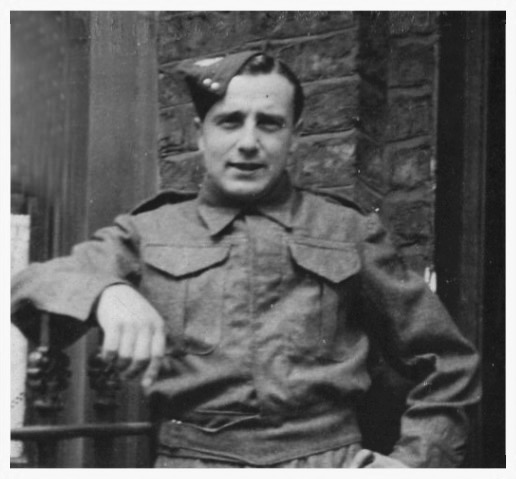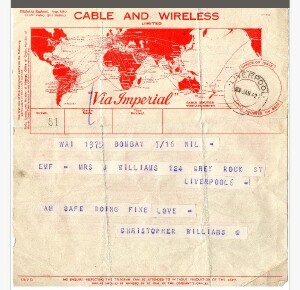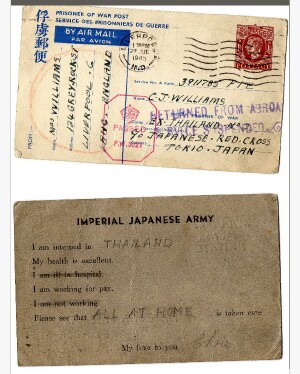|
Thai-Burma Death Railway Camps |
Main Index Camp List About Us
| Naming Standards This naming convention, developed by Neil MacPherson of Australia and accepted by the Center For Research, Allied POWS Under The Japanese, sets out the known details of the camps on the Burma Thailand Railway and makes allowances for the spelling differentials. Neil and Rod Beattie have worked to make this as accurate as possible. Rod Beattie has worked diligently on this project for years and was instrumental in developing the Death Railway Musuem in Thailand. For those who worked on the Burma end, the men used the distance from Base Thanbyuzayat as camp names. Example: 35 Kilo Camp, MacPherson's first camp in Thailand; the tendency was to use the name of the nearest village, so the list below gives both name (Tanyin) and kilo (35) camp designation. (As of 29 Sept 2005) Chart of Movements -- Detail of Movements Information on Thailand-Burma Railway Centre Dutch perception of Death Railway No20-196_Thailand_POW_Camp_Deaths_1943 (JPG) Additional Links: Death Railway - Thailand-Burma Railway (FEPOW) Burma Thailand Railway Memorial Association US POWs on the Thai-Burma Railway Archival Documents from NARA: Statistics and maps of Thai-Burma Railway - number of patients, health condition, diseases, deaths, distribution of POWs along railway
THAI-BURMA RAILWAY - Assorted maps of the TBR (poor image quality) Asst. original documents on Thailand camps (RG 24 Box 6) - Report on camps by John Slaughter (Royal Norfolk Regiment), with maps; Swiss telegrams re USS Houston survivors, list of American POWs in Thailand; lists of British and Dutch POWs; deceased in Saigon camp; grave lists and detailed locations (Apparon 80-kilo camp, Sino Anganan 100-kilo camp, Cemetery #1 Kanchanaburi); Roselle death certificate; British, American and Australian POWs killed by bombings at camps in Thailand, Mukden, Taiwan, Osaka, Tokyo, Fukuoka, Sendai (includes some casualty cards) JAG Files on Malaya camps (RG 153 Box 105) - Rangoon camp, Maymyo camp Burma, Tamarkan camp Thailand CELLUM testimony, Incidents in Thai camps, Serang and Thai camp reports, Borneo camps, few pages from Treatment of Malayan People and Singapore camp report Asst. Place Name Cards for Java Camp Group Area (RG 153 Box 7, JAG files) - cards are mixed in with other area camps, contain many names and places relating to deaths, news events, atrocities, etc. Burma, Thailand, Siam camps (RG 389 Box 2120) - Harrell Report on Tamwan, Siam; Petchaburi, Siam; Moulmein, Burma (camp sketch); List of Java and South East Asia camps p1 - p2 - p3 - p4; Duffy drawings (see below); Ban Pang, Siam Airport Camp, Makasuri, Pakan Bahru (Serang Civil Prison, Batavia and Singapore camp sketches); Norwood at Truk jail (sketch); Kellogg Report on Bangkok; Gorski letter to Norwood; Map of Norwood trip to Singapore; 142nd General Hospital roster; Gorski report on Sumatra; Tamarakan camp, Siam (camp sketch); Camp map Thai-Burma Railway; Report on Malaya camps; Hamlin statement USS Houston; Clark letter to Norwood; Color map of TBR; Burma camp photos 1 - 2 - 3 - 4; Schram affidavit; Summers affidavit; Rogers report on 100 Kilo camp (sketch); Heinen report on 100 Kilo camp (sketch); Letter to Barrett; Stensland report on Thanbyuzayat Burma; Norwood map of TBR; Pryor letter on 80 Kilo camp; Summers report on Tamarkan (camp sketch); Keithly affidavit; Thai camp photo; Tamuang camp photos 1 - 2; Slaughter report on Thai camps; Map of prison camps near Kanchanaburi; Chung Kia camp sketch Burma, Thailand, Siam camps (RG 389 Box 2120A) - 80 Kilo camp (sketch); Bangkok; Mail drop from Rabaul Aussies; Rasbany report on Brenkassey Thailand; Kanbury Thailand huts photo; Leon report on Nakhon Pathon Thailand; Pryor report on Technicians camp Thailand; Rasbany report on Tamajoe Thailand (sketch); Condition of POWs on TBR Thailand Camps Death Roster and SEA Camps Report (RG 389 Box 2155) - Death roster for 136 US, Canada, Denmark, New Zealand POWs (1942-08-15 to 1945-09-05); Locations of camps on TBR in Japanese p1 - p2 - p3; Report on POW Camps in SE Asia taken from info from POWs and civilian internees (75 pages) Rosters: MALAYA_THAILAND_Vol 1_Australian_roster Part 1 - Part 2 (RG 407 Box 120) MALAYA_THAILAND_Vol2_British_roster (RG 407 Box 120) Volume/Folder 2: Thai
POW Camp Name List as of Nov. 1, 1944. Roster of British POWs in
Thailand. This roster appears to be a continuation of the British
roster in Volume I in Box 120 of RG 407. It starts
with the "H" names on page 2 (in pencil at the bottom of the page),
presumed to be page 180 at the top (not shown on this page, but the
following page is numbered 181 at the top). Goes through the "Z" names
on page 203 (in pencil at the bottom), which is also page 379 (in print
at the top). [Last two pages of this file are the cover page and page
265 for Volume/Folder IV.]
MALAYA_THAILAND_Vol 3_Dutch_roster Part 1 - Part 2 (RG 407 Box 121)MALAYA_THAILAND_Vol 4_Dut_Aus_Other_rosters Part 1 - Part 2 - Part 3 (RG 407 Box 121) - Dutch, Australian; Canadian, New Zealand, Danish, French, Greek (from p. 259) MALAYA British deaths (some Dutch) (RG 407 Box 174) - Unreported Deaths of Allied Personnel. March - October 1943. BURMA-04_roster (WO 361-2204) - British and American POWs at Burma Camp 6, later IV. Some rosters show if living, dead or killed in action (KIA), cause of death and burial site. THAILAND_POW_Camps_rosters (WO 361-2171) - Numerous rosters of POWs in Thailand. All nationalities listed by camp and/or party. These camps and parties include: Honshu No. 3, No. 1 Branch, No. 2 Branch, Akrodome Camp - Musicians - III, Tamuan - III, Honshu No. 4, Tamarkan 300 Party - III, Burma - Lonshi - 3 Branch, Burma - 75 Meiloe Party, Burma - Apalon - III, Nonpladuk - III, Honbu - III, Nakompatong - III, Hen-Da-Tai - III, and Escapes - III. THAILAND-01_Roster Part 1 - Part 2 (WO 361-2170) - Two rosters of Dutch, British and Australian POWs. 2nd roster is of deceased POWs. THAILAND-07_British_roster_A-N Part 1 - Part 2 (WO 361-2172) THAILAND-10_Saigon_roster (WO 361-2000) - Rosters of British, Australian and Dutch POWs. Part I = Personnel in Camp; Part II = Attached No. 8 Group; Part III = Saigon No. 8 Group; Part IV = Officers No. 7 Group (no pages); Part V = Deceased; Part VI = Escaped. THAILAND_Deaths (WO 361-1518) - Statistics all in Japanese, by grave site and nationality THAILAND_Main_Camp_Deaths Part 1 - Part 2 (WO 361-1526) and THAILAND_Main_Camp_Maps_Deaths Part 1 - Part 2 (WO 361-1526) - August 1942 to December 1943. Many entries and pages are in Japanese. Anglo and Dutch names all mixed together, and are NOT in alphabetical order. THAI-BURMA-RR_deaths_cemeteries (WO 361-2235) - Thai-Burma Railway camps; death rolls; cemetery details, with sketches. Maps and causes of death included for most cemeteries. Also lists of amputations and causes. Mostly British, Dutch and Australians. Cemeteries:Tamuan, Tasao (1, 2, 3 - Cholera), Tonchan (Main, South, Spring and Cholera), Tampi, Kanyu (1, Lower Main, Upper 2, Lower 2, Upper 3), Kinsayoke, Kinsaiyoku 1 Jungle, Kinsayoke 2 Jungle, Kinsayoke Dutch, Wampo, Hintock, Klian Klai, Chunkai, Chunkai South, Chungkai 4 South, Tamakan, Nakom Patom, Kanburi, St. Luke's, Timonta, 243 Kilo, Namuchonyai, Wampo, Tasao 2, Near Wanyai, Bonde, Nonpladuk, Between Wanyai and Tardan, Konquita, Hindato, Longi 62 K, Non Pladuk, Pungysho, Changi, Takanun, Brenkasi, Near Wampo North, 190 Kilo, 213 Kilo, Bandapong, Thai 1 Shiu Sheky Sho, Pratchapkirikan, Noohin, Minowa, Takyle, Takiri, Ratburi, Pakudo, Niki, 1 1/2 Kilo, Sonkrai SW, Village and Station, 229 Kilo, Krekonta, Tamajo, Takuri, Pratchai and 13 Kilo. SIAM American deaths (RG 407 Box 190) - April 1943 to November 1944 (camp undetermined) SIAM British deaths (some Dutch) (RG 407 Box 174) - Unreported Deaths of Allied Personnel (British). August 1942 - May 1945. Capt. Benjamin Barnett Diary, Australian 8th Division Signals F Force - covers period from Changi to Burma; used as exhibit in Tokyo War Crimes Trials, containing payment info and transfers to other camps (transcription, DOCX file) M354--18E Japanese Administration of Occupied Areas, Thailand 15 December 1944 Report No 36-a(27) USSBS Index Section 6-s Books and Videos: The Burma Railroad - The Drawings of Jack Chalker - The sample pages give you an idea of the depth of anguish suffered by the men who slaved for Japan on the infamous railroad. While not reviewed, we have seen numerous example of Jack Chalker's drawings and believe this should be part of any serious POW book collection. (Cover Image) Sears Eldredge - Audio and video interviews; book download (Captive Audiences, Captive Performers) Drawings by Duffy: Folder 2 - Page 1
- German Kriegsmarine ship
Folder 2 - Page 2 - Tandjoeng Priok chapel Folder 2 - Page 3 - American Leader ship Folder 2 - Page 4 - Camp 6 Tandjoeng Priok barracks Folder 2 - Page 5 - St George's chapel Folder 2 - Page 6 - Batavia Bicycle camp cookhouses Folder 2 - Page 7 - Batavia Bicycle camp room Folder 2 - Page 8 - Makassar general view Leslie George Hallett (Driver, Royal Army Service Corps) Collection (courtesy of Barbara Hawkins) "We have in our possession a copy
of the Christmas Day menu for 1943. This was given to us by a member of
his family. He was a prisoner and worked on the bridge. After his
release and return to England he was so traumatised that he spent years
on his own building two models of the bridges.These were found by his family after his death and are now exhibited at the National Memorial Arboretum Museum."
Roger Stone (1120606), died Oct. 20, 1943, age 23 - Photo front, back (courtesy of Elizabeth Sargent) Photos: Christopher Williams
"My uncle Christy, i.e. he married my mother's sister Frances, but he was
also my dad's 1st cousin. I find a card which says 'I am working for
pay'... ironic, because I don’t think they got round to paying him. I
have fond memories of him, he was very philosophical about the
Japanese. Dad said Christy said they lived by different conventions...
if a Japanese soldier surrendered, he was worthless and dishonoured, so
they didn’t think much of the allied POWs." (Courtesy of Maria Owen)Born: October 1915, Liverpool Died: March 1982, Liverpool Rod Beattie, Kanchanaburi resident, kindly made available all his data for researching of this project. He has spent many years exploring and researching railway sites and has built a Railway Information Centre in Kanchanaburi.
|



